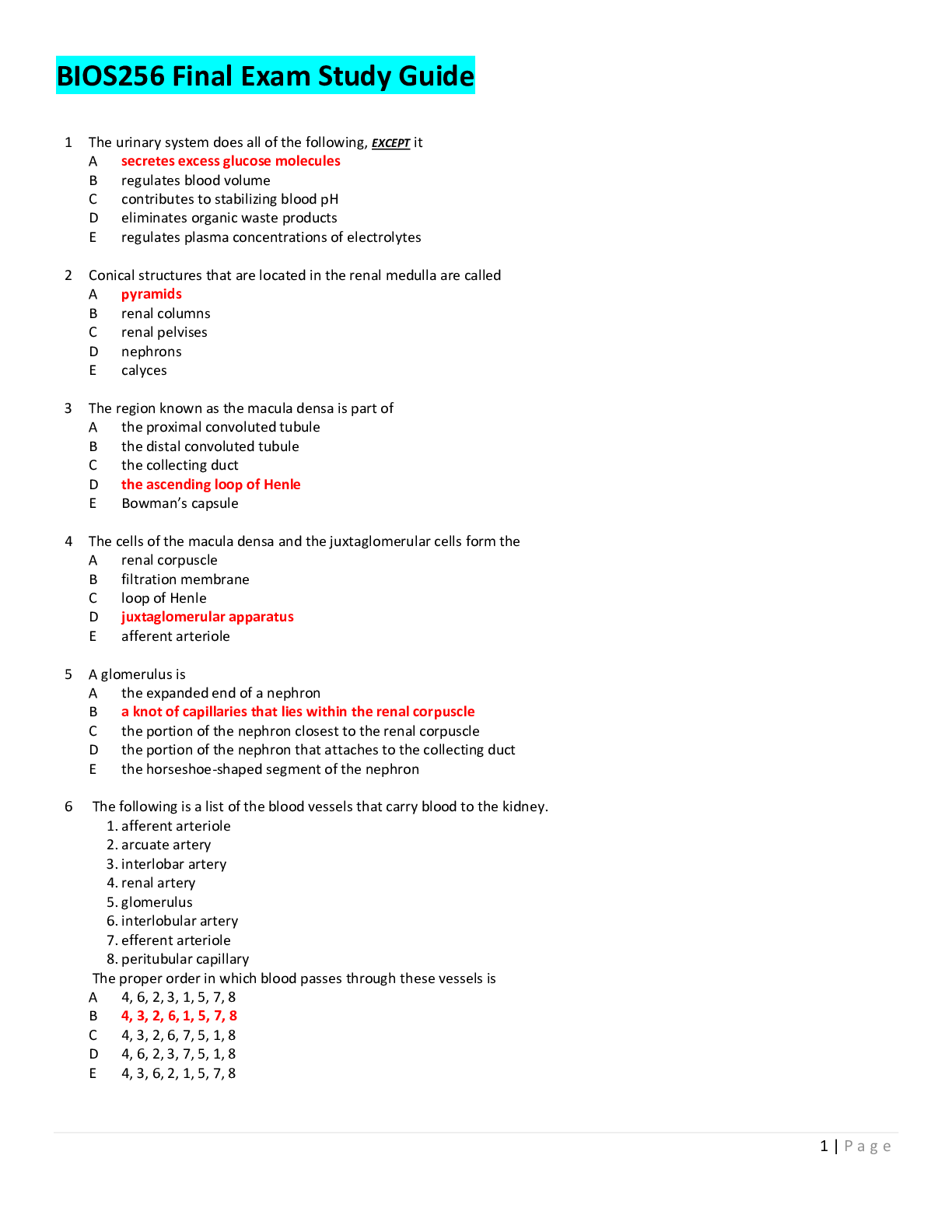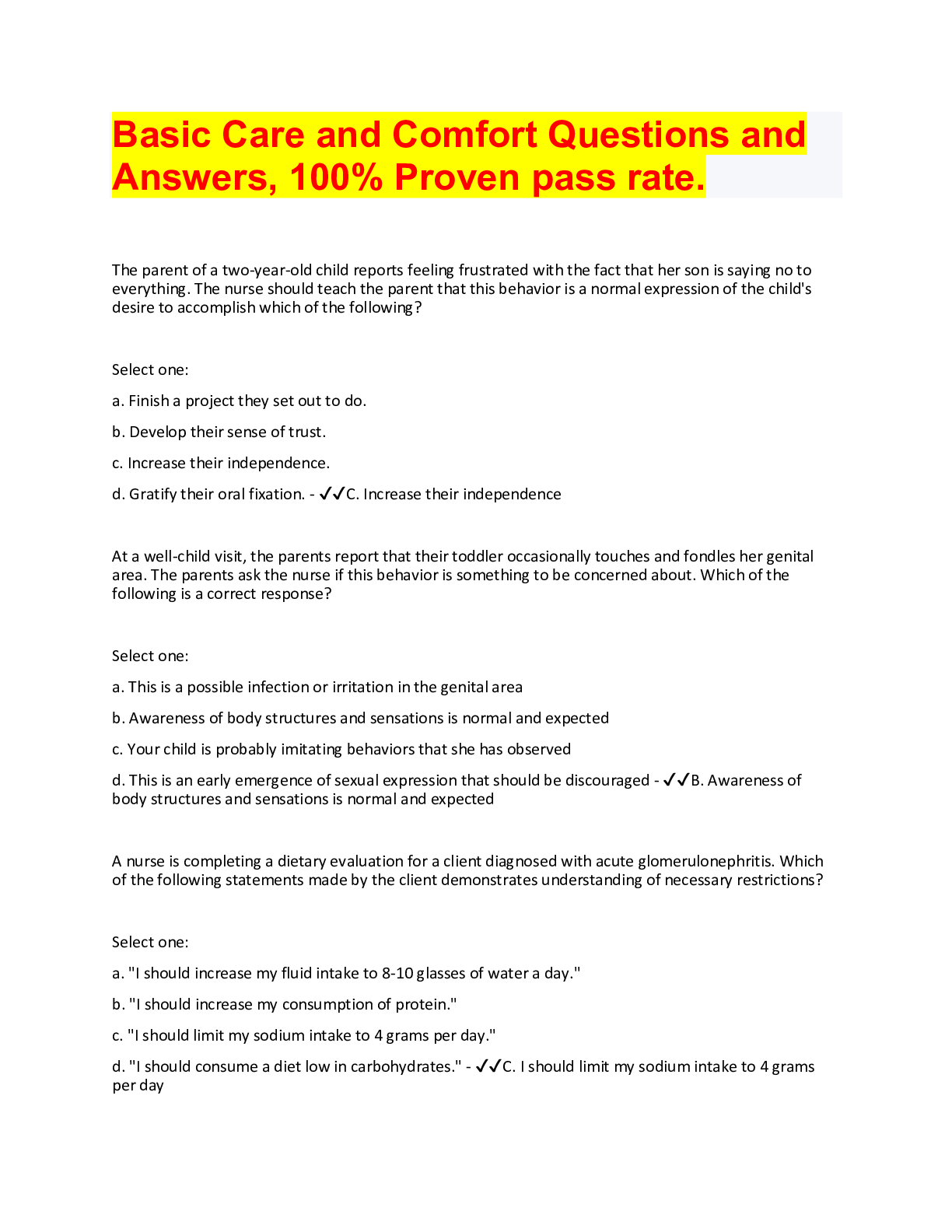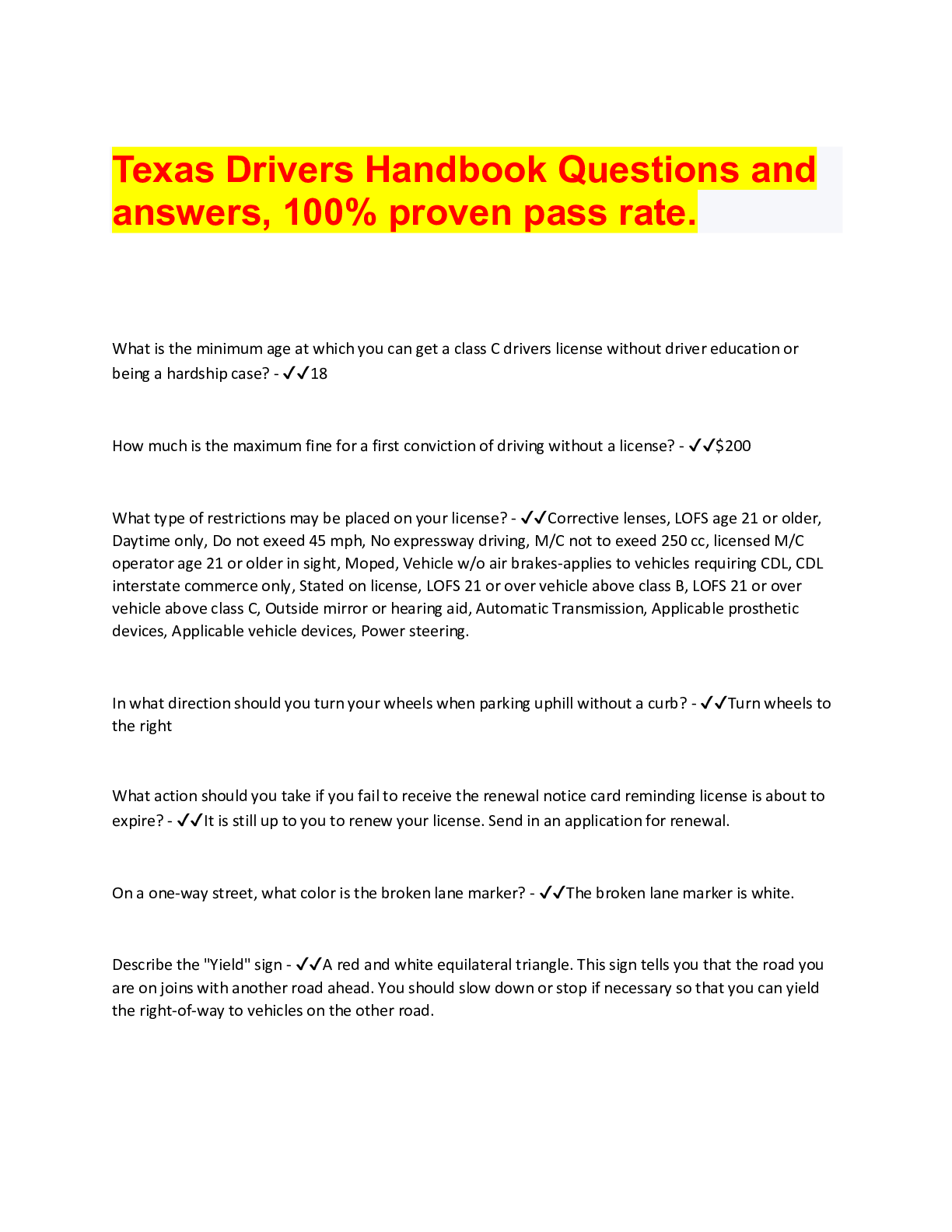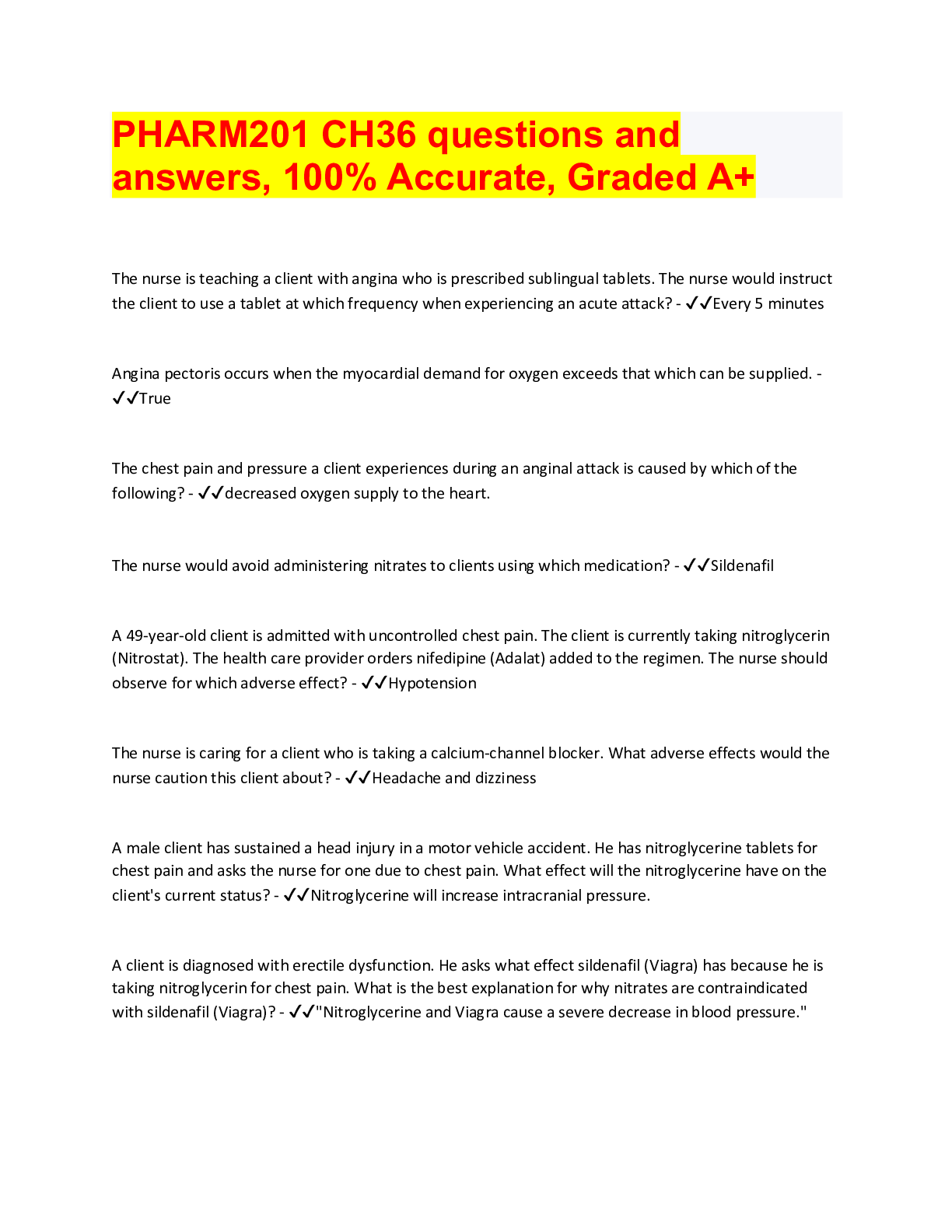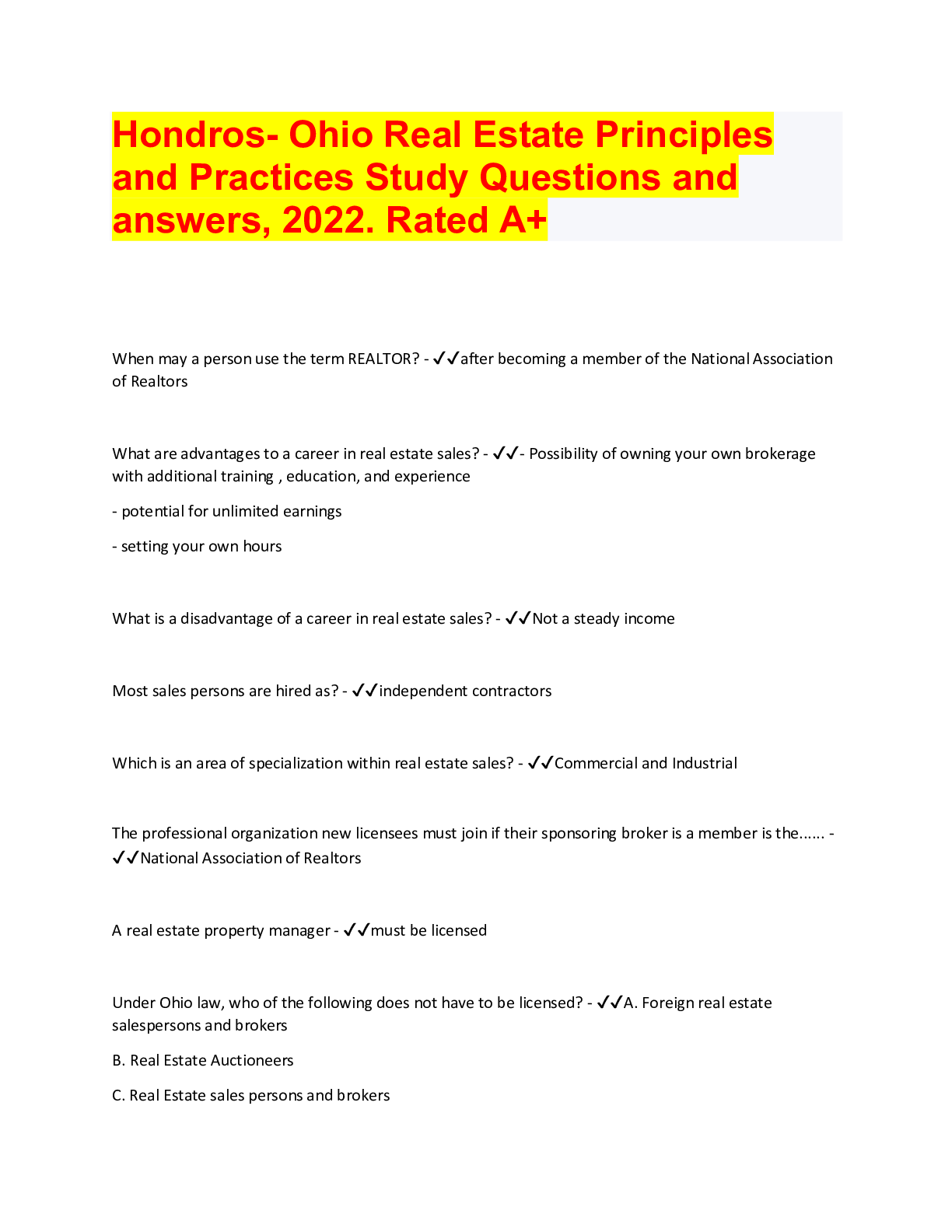*NURSING > QUESTIONS & ANSWERS > PANCE Practice Exam #1 questions and answers, 100% rated A. 2022 (All)
PANCE Practice Exam #1 questions and answers, 100% rated A. 2022
Document Content and Description Below
PANCE Practice Exam #1 questions and answers, 100% rated A. 2022 1. A 52 year-old male presents complaining of urinary frequency, with hesitancy, and nocturia for the past few months. During his ... physical examination, you note a nontender, non-enlarged prostate with an isolated right posterior lobe nodule. Which of the following options is most appropriate? A. order a serum acid phosphatase level B. initiate prazocin and schedule a follow-up appointment in 6 weeks C. refer the patient for an ultrasound of the prostate and order a PSA level D. reassure the patient and schedule a follow-up appointment in six months E. initiate norfloxacin therapy for seven days and schedule follow-up in twoweeks - ✔✔1. C. This patient has an isolated nodule of the prostate gland — cancer until proven otherwise. You should order an ultrasound and a PSA. BPH will present as diffuse enlargement, and not a discrete nodule. 2. Which term is used to describe the characteristic concave or "spoon-shaped" nails of iron deficiency anemia? A. leukonychia B. koilonychias C. clubbing D. onycholysis E. paronychia - ✔✔2. B. Koilonychia is a spoon-shaping of the nail itself. Clubbing is a thickening of the nail bed which "lifts" the nail - it is a sign of increased TNF (tissue necrosis factor), most likely occurring in cystic fibrosis, bronchiectasis or lung cancer. A & D are not real words, (onychomycosis is the real term for fungal infection of the nail)..E is paronychia and is an infection of the nailbed. 3. Which of the following is NOT a characteristic feature of the nephotic syndrome? A. proteinuria B. hematuria C. hypoalbuminemia D. hyperlipidemia E. generalized edema - ✔✔3. B. Hematuria is present in NEPHRITIC syndrome. Nephrotic syndrome characteristically includes proteinuria (>3.5 gm/day), with resulting low serum albumin, hyperlipidemia, hypertension, hypercoagulability, and generalized edema (from oncotic third-spacing) 4. A patient describes a history of recurrent bouts ofuveitis. Her chemistry panel reveals elevated serum calcium and uric acid levels. Her anergy screen is negative. Her chest x-ray deomstrates bilateral hilar adenopathy. Which diagnosis is most likely? A. Silicosis B. Sarcoidosis C. Alpha-1 antitrypsin deficiency D. Histoplasmosis E. Tuberculosis - ✔✔4. B. Sarcoid typically presents with hilar lymphadenopathy and noncaseating granulomas of the lungs (and other organs). In addition, patients may get eye involvement (uveitis). Elevations of ACE, Calcium and uric acid are frequently seen. 5. A 34 year-old female presents complaining of symmetrical redness and swelling of the small joints of her hands (PIPs and MCPs). She has noted that the symptoms are worst in the morning. Her erythrocyte sedimentation rate is elevated and her rheumatoid factor is negative. Which of the following diagnosis is most likely? A. progressive systemic sclerosis B. CREST syndrome C. osteoarthritis D. rheumatoid arthritis E. ankylosing spondylitis - ✔✔5. D. In spite of the negative RF, Rheumatoid arthritis is the most likely diagnosis. RA characteristically includes small joint symmetrical arthritis, with an elevated ESR (therefore inflammatory, and not OA). 80 of patients with RA will have a positive RF, but 20 will be negative. PSS involves squamous cell thickening and sclerosis causing taut skin of the face and hands and difficulty with esophageal motility. CREST syndrome is a subset of PSS; Ankylosing spondylitis would have an elevated ESR and negative RF, but mainly involves the SI joint and lumbar/thoracic spine fusion (bamboo spine) 6. A 27 year-old nulliparous female presents because she's been trying to get pregnant for two years, but has failed. She relates a history ofamisdiagnosis of appendicitis that lead to abscess formation when she was 14 years old. Which of the following diagnostic studies would be most helpful at this point in her evaluation? A. TSH level B. hysterosalpingogram C. laparoscopy D. PAP smear E. pelvic ultrasound - ✔✔6. B. While I would disagree that an invasive procedures like HSG should be done first- line, the thing to remember in this question is that the patient has reason to have tubal scarring from adhesions (and there is no better answer listed to choose), so, for a Board exam I would choose this answer. The TSH level would not be indicated (she has not had a pg loss), lap could diagnose the tubal scarring but would be done after an abnormal HSG. Pap smear is screening for cervical cancer and not indicated in this case of infertility; and pelvic US would yield nothing diagnostically about the tubes. 7. A 14 year-old is experiencing a severe asthma attack. Although he is using accessory muscles to breath, auscultation of his chest reveals no audible wheezing. His heart rate is 160 and his respiratory rate is 52. Which of the following arterial blood gases represents the worst prognosis? A. pH = 7.52; pC02 = 28; p02 = 80 B. pH = 7.44; pC02 =38; p02 = 70 C. pH = 7.60; pC02 = 18; p02 = 60 D. pH = 7.40; pC02 = 40; p02 = 60 E. pH = 7.27; pC02 = 62; p02 = 64 - ✔✔7.E. This patient has a RR of 52. If she is ventilating, she is blowing of C02 (an acid) and would be alkalotic and should have a low C02. A pH which is acidic with a pC02 which is elevated means that she is no longer ventilating at all (she needs mechanical ventilation or she will die). 8. A 48 year-old nurse, with a body mass index of 31, presents for an evaluation for back pain. She relates that historically, she had a positive PPD test a year ago and did not follow-up as directed. She has recently been experiencing night sweats and coughing. An x-ray other lumbar spine reveals osteopenia and cortical breakdown of vertebral bodies L4 and L5. Which of the following diagnosis is most suspect? A. compression fractures secondary to obesity B. degenerative joint disease C. Potts disease D. compression fractures secondary to osteoporosis E. spondylolisthesis - ✔✔8. C. Pott's disease is TB of the spine. She could have any of the other diseases; but the question states that she had a positive PPD and did not take meds.. .that is [Show More]
Last updated: 2 years ago
Preview 1 out of 10 pages
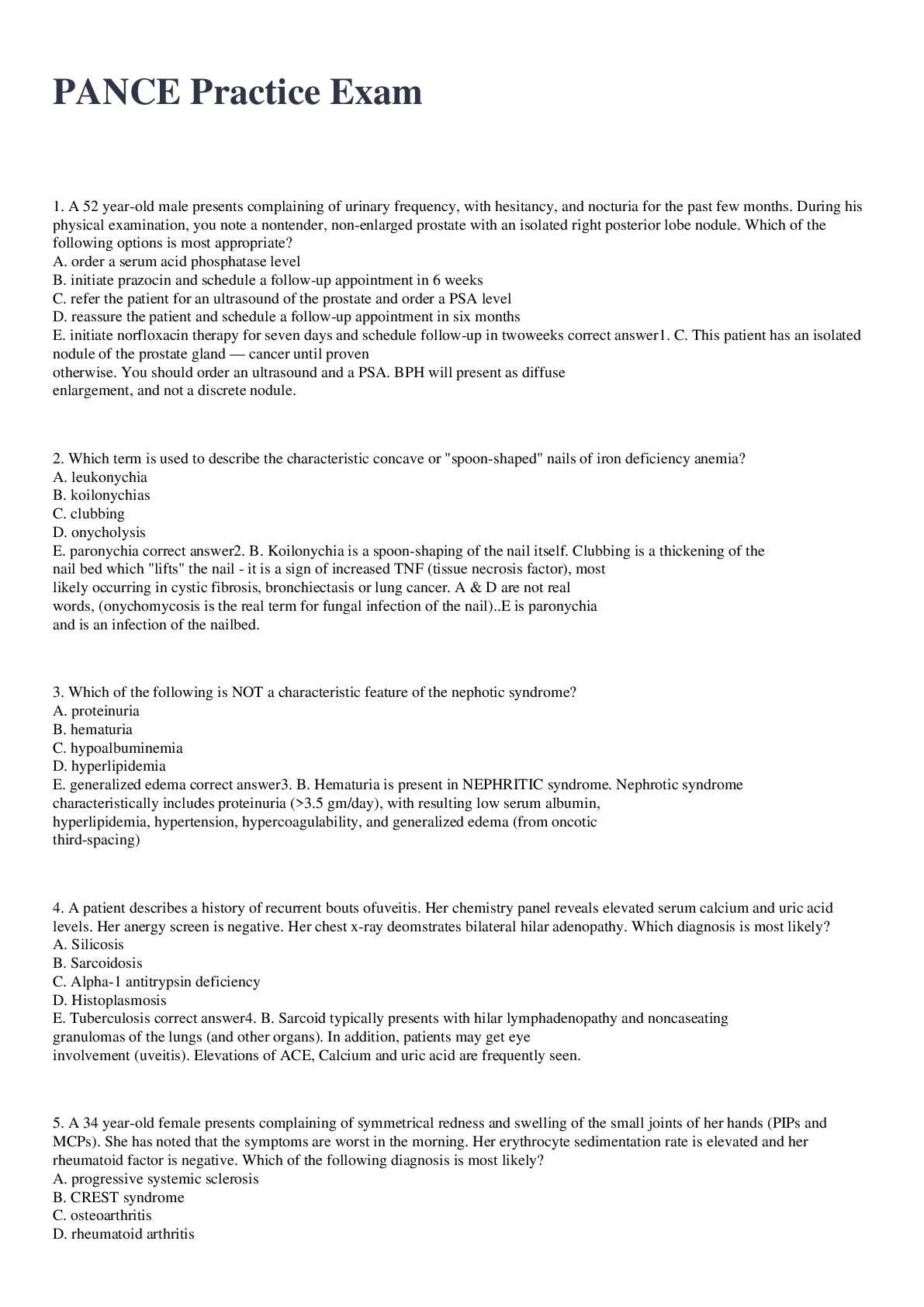
Buy this document to get the full access instantly
Instant Download Access after purchase
Buy NowInstant download
We Accept:

Also available in bundle (1)

PANCE EXAM BUNDLE,
ALL YOU NEED TO PASS THE PANCE EXAM, DOWNLOAD TO SCORE HIGH
By bundleHub Solution guider 2 years ago
$38
11
Reviews( 0 )
$12.00
Can't find what you want? Try our AI powered Search
Document information
Connected school, study & course
About the document
Uploaded On
Aug 20, 2022
Number of pages
10
Written in
Seller

Reviews Received
Additional information
This document has been written for:
Uploaded
Aug 20, 2022
Downloads
0
Views
127












